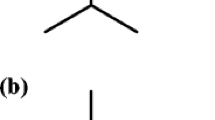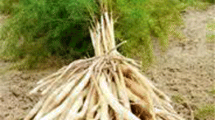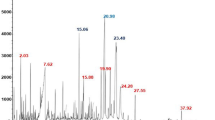Abstract
In recent times, there were considerable efforts made to promote the use of environmentally friendly and biodegradable natural insecticides and repellents, particularly from botanical sources. The present study explored the effects of crude leaf ethyl acetate, acetone, and methanol extracts of Aegle marmelos (L.) Correa ex Roxb, Andrographis lineata Wallich ex Nees., Andrographis paniculata (Burm.f.) Wallich ex Nees., Cocculus hirsutus (L.) Diels, Eclipta prostrata L., and Tagetes erecta L. on repellent activity against Culex tritaeniorhynchus Giles. The maximum repellent activity was observed at 500 ppm in methanol extracts of A. marmelos, ethyl acetate extracts of A. lineata, C. hirsutus, and E. prostrata and the mean complete protection time ranged from 120 to 150 min with the different extracts tested. The ethyl acetate extract of A. lineata showed 100% repellency in 120 min; acetone extracts of A. marmelos and C. hirsutus and methanol extract of T. erecta showed complete protection in 90 min at 250 ppm, respectively. These results suggest that the leaf extracts of A. marmelos, A. lineata, and C. hirsutus have the potential to be used as an ideal eco-friendly approach for the control of the C. tritaeniorhynchus. Therefore, this study provides first report on the repellent activity against Japanese encephalitis, C. tritaeniorhynchus of plant extracts from Southern India.
Similar content being viewed by others
References
Aguilar HH, de Gives PM, Sánchez DO, Arellano ME, Hernández EL, Aroche UL, Valladares-Cisneros G (2008) In vitro nematocidal activity of plant extracts of Mexican flora against Haemonchus contortus fourth larval stage. Ann N Y Acad Sci 1149:158–160
Amer A, Mehlhorn H (2006a) Larvicidal effects of various essential oils against Aedes, Anopheles, and Culex larvae (Diptera, Culicidae). Parasitol Res 99:466–472
Amer A, Mehlhorn H (2006b) Repellency effect of forty-one essential oils against Aedes, Anopheles, and Culex mosquitoes. Parasitol Res 99(4):478–490
Bagavan A, Kamaraj C, Rahuman AA, Elango G, Zahir AA, Pandiyan G (2009) Evaluation of larvicidal and nymphicidal potential of plant extracts against Anopheles subpictus Grassi, Culex tritaeniorhynchus Giles and Aphis gossypii Glover. Parasitol Res 104:1109–1117
Bright AA, Babu A, Ignacimuth S, Dorn S (2001) Efficacy of crude extracts of Andrographis paniculata nees. on Callosobruchus chinensis L. during post harvest storage of cowpea. Indian J Exp Biol 39:715–718
Broussalis AM, Ferraro GE, Martino VS, Pinzón R, Coussio JD, Alvarez JC (1999) Argentine plants as potential source of insecticidal compounds. J Ethnopharmacol 67:219–223
Burkill IH (1966) A dictionary of the economic products of the Malay Peninsula, vol I & II. Ministry of Agriculture and Co-operatives, Kuala Lumpur, p 2444
Casida JE, Quistad GB (2000) Insecticide targets: learning to keep up with resistance and changing concepts of safety. Agric Chem Biotechnol 43:185–191
Curtis CF, Lines JD, Baolin L, Renz A (1991) Natural and synthetic repellents. In: Curtis CF (ed) Control of disease vectors in the community. Wolf, London, pp 75–92
Dutta A, Sukul NC (1982) Filaricidal properties of a wild herb, Andrographis paniculata. J Helminthol 56:81–84
Elango G, Rahuman AA, Bagavan A, Kamaraj C, Zahir AA, Venkatesan C (2009a) Laboratory study on larvicidal activity of indigenous plant extracts against Anopheles subpictus and Culex tritaeniorhynchus. Parasitol Res 104:1381–1388
Elango G, Bagavan A, Kamaraj C, Zahir AA, Rahuman AA (2009b) Oviposition-deterrent, ovicidal, and repellent activities of indigenous plant extracts against Anopheles subpictus Grassi (Diptera: Culicidae). Parasitol Res 105:1567–1576
Elango G, Rahuman AA, Bagavan A, Kamaraj C, Zahir AA, Rajakumar G, Marimuthu S, Santhoshkumar T (2010) Efficacy of botanical extracts against Japanese encephalitis vector, Culex tritaeniorhynchus. Parasitol Res 106(2):481–492
Fradin MS, Day JF (2002) Comparative efficacy of insect repellents against mosquito bite. New Engl J Med 347:13–18
Ganapaty S, Dash GK, Subburaju T, Suresh P (2002) Diuretic, laxative and toxicity studies of Cocculus hirsutus aerial parts. Fitoterapia 73:28–31
Govere J, Braack LEO, Durrheim DN, Hunt RH, Coetzee M (2001) Repellent effects on Anopheles arabiensis biting humans in Kruger Park, South Africa. Med Vet Entomol 15(3):287–292
Govindarajan M (2009) Bioefficacy of Cassia fistula Linn. (Leguminosae) leaf extract against chikungunya vector, Aedes aegypti (Diptera: Culicidae). Eur Rev Med Pharmacol Sci 13:99–103
Jaenson TG, Pålsson K, Borg-Karlson AK (2006) Evaluation of extracts and oils of mosquito (Diptera: Culicidae) repellent plants from Sweden and Guinea-Bissau. J Med Entomol 43:113–119
Kamaraj C, Rahuman AA, Bagavan A (2008) Antifeedant and larvicidal effects of plant extracts against Spodoptera litura (F.), Aedes aegypti L. and Culex quinquefasciatus Say. Parasitol Res 103(2):325–331
Kamaraj C, Bagavan A, Rahuman AA, Zahir AA, Elango G, Pandiyan G (2009) Larvicidal potential of medicinal plant extracts against Anopheles subpictus Grassi and Culex tritaeniorhynchus Giles (Diptera: Culicidae). Parasitol Res 104(5):1163–1171
Karunamoorthi K, Mulelam A, Wassie F (2008a) Laboratory evaluation of traditional insect/mosquito repellent plants against Anopheles arabiensis, the predominant malaria vector in Ethiopia. Parasitol Res 103(3):529–534
Karunamoorthi K, Ramanujam S, Rathinasamy R (2008b) Evaluation of leaf extracts of Vitex negundo L. (Family: Verbenaceae) against larvae of Culex tritaeniorhynchus and repellent activity on adult vector mosquitoes. Parasitol Res 103:545–550
Khanna VG, Kannabiran K, Getti G (2009) Leishmanicidal activity of saponins isolated from the leaves of Eclipta prostrata and Gymnema sylvestre. Indian J Pharmacol 41(1):32–35
Lee SE, Kim JE, Lee HS (2001) Insecticide resistance in increasing interest. Agric Chem Biotechnol 44:105–112
Liu N, Xu Q, Zhu F, Zhang L (2006) Pyrethroid resistance in mosquitoes. Insect Sci 13:159–166
Mehlhorn H, Schmahl G, Schmidt J (2005) Extract of the seeds of the plant Vitex agnus castus proven to be highly efficacious as a repellent against ticks, fleas, mosquitoes and biting flies. Parasitolo Res 95:363–365
Mullai K, Jebanesan A, Pushpanathan T (2008) Mosquitocidal and repellent activity of the leaf extract of Citrullus vulgaris (cucurbitaceae) against the malarial vector, Anopheles stephensi liston (diptera culicidae). Eur Rev Med Pharmacol Sci 12(1):1–7
Natarajana N, Corkb A, Boomathia N, Pandia R, Velavana S, Dhakshnamoorthy G (2006) Cold aqueous extracts of African marigold, Tagetes erecta for control tomato root knot nematode, Meloidogyne incognita. Crop Protection 25:1210–1213
Pitasawat B, Choochote W, Tuetun B, Tippawangkosol P, Kanjanapothi D, Jitpakdi A, Riyong D (2003) Repellency of aromatic turmeric Curcuma aromatica under laboratory and field conditions. J Vector Ecol 28:234–240
Rahuman AA, Gopalakrishnan G, Venkatesan P, Geetha K (2008) Isolation and identification of mosquito larvicidal compound from Abutilon indicum (Linn.) Sweet. Parasitol Res 102(5):981–988
Rahuman AA, Bagavan A, Kamaraj C, Saravanan E, Zahir AA, Elango G (2009) Efficacy of larvicidal botanical extracts against Culex quinquefasciatus Say (Diptera: Culicidae). Parasitol Res 104:1365–1372
Ramya S, Jayakumararaj R (2009) Antifeedant Activity of Selected Ethno-botanicals used by Tribals of Vattal Hills on Helicoverpa armigera (Hübner). J Pharm Res 2(8):1414–1418
Ravi V, Vanajakshi S, Gowda A, Chandramuki A (1989) A laboratory diagnosis of Japanese encephalitis using monoclonal antibodies and correlation of findings with the outcome. J Med Virol 29:221–223
Reuben R, Gajanana A (1997) Japanese encephalitis in India. Indian J Pediatr 64:243–251
Samarasekera JK, Khambay BP, Hemalal KP (2004) A new insecticidal protolimonoid from Aegle marmelos. Nat Prod Res 18(2):117–122
Sarkari NBS, Barthwal SP, Gupta AK, Bagga MMS, Mishra SN,Mishra VK (1984) A clinical appraisal of two epidemics ofJapanese encephalitis in eastern Utter Pradesh. In: Proceedings of National conference on Japanese encephalitis, pp 34–40
Sawangjaroen N, Subhadhirasakul S, Phongpaichit S, Siripanth C, Jamjaroen K, Sawangjaroen K (2005) The in vitro anti-giardial activity of extracts from plants that are used for self-medication by AIDS patients in southern Thailand. Parasitol Res 95(1):17–21
Singh RN, Saratchandra B (2005) The development of botanical products with special reference to seri-ecosystem. Caspian J Env Sci 3:1–8
Sokal RR, Rohlf JF (1981) Biometry principles and practice of statistics in biological research, 2nd edn. WH Freeman and Company, New York
Sugati SS, Sudjaswadi W, Rini S, Wien W (1999) Andrographis paniculata (Burm.f.) Wallich ex Nees. In: de Padua LS, Bunyapraphatsara N, Lemmens RHMJ (eds) PROSEA—plant resources of Southeast Asia No. 12(1). Medicinal and poisonous plants 1. Backhuys, Leiden, pp 119–123
Suman DS, Shrivastava AR, Parashar BD, Pant SC, Agrawal OP, Prakash S (2008) Scanning electron microscopic studies on egg surface morphology and morphometrics of Culex tritaeniorhynchus and Culex quinquefasciatus (Diptera: Culicidae). Parasitol Res 104(1):173–176
Tawatsin A, Asavadachanukorn P, Thavara U, Wongsinkongman P, Bansidhi J, Boonruad T, Chavalittumrong P, Soonthornchareon N, Komalamisra N, Mulla MS (2006) Repellency of essential oils extracted from plants in Thailand against four mosquito vectors (Diptera: Culicidae) and oviposition deterrent effects against Aedes aegypti (Diptera: Culicidae). Southeast Asian J Trop Med Public Health 37:915–931
Tawatsin A, Wratten SD, Scott RR, Thavara U, Techandamrongsin Y (2001) Repellency of volatile oils from plants against three mosquito vectors. J Vector Ecol 26:76–82
Tyagi BK, Ramnath T, Shahi AK (1994) Evaluation of repellency effect of Tagetus minuta (Family: Compositae) against the vector mosquitoes Anopheles stephensi Liston. Culex quinquefasciatus Say and Aedes aegypti (L.). Int Pest Contr 39:48
Venkatachalam MR, Jebanesan A (2001) Repellent activity of Ferronia elephantum Corr. (Rutaceae) leaf extract against Aedes aegypti (L.). Bioresour Technol 76:287–288
Yang YC, Lee SG, Lee HK, Kim MK, Lee SH, Lee HS (2002) A piperidine amide extracted from Piper longum L. fruit shows activity against Aedes aegypti mosquito larvae. J Agric Food Chem 50:3765–3767
Zaridah MZ, Idid SZ, Omar AW, Khozirah S (2001) In vitro antifilarial effects of three plant species against adult worms of subperiodic Brugia malayi. J Ethnopharmacol 78:79–84
Acknowledgment
The authors are grateful to C. Abdul Hakeem College Management, Dr. S. Mohammed Yousuff, Principal, Dr. K. Abdul Subhan, Reader, and HOD of Zoology Department, for their help and suggestion.
Author information
Authors and Affiliations
Corresponding author
Rights and permissions
About this article
Cite this article
Elango, G., Rahuman, A.A., Zahir, A.A. et al. Evaluation of repellent properties of botanical extracts against Culex tritaeniorhynchus Giles (Diptera: Culicidae). Parasitol Res 107, 577–584 (2010). https://doi.org/10.1007/s00436-010-1897-8
Received:
Accepted:
Published:
Issue Date:
DOI: https://doi.org/10.1007/s00436-010-1897-8




